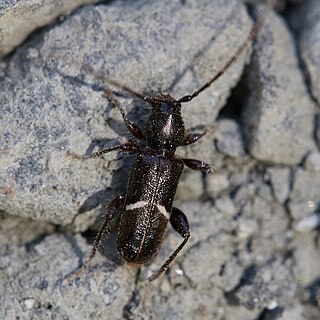Phymatodes aeneus is a species of longhorn beetle in the family Cerambycidae, found in North America.

Phymatodes aereus is a species of longhorn beetle in the family Cerambycidae. It is found in North America.

Phymatodes amoenus, the grapevine phymatodes, is a species of longhorn beetle in the family Cerambycidae. It is found in North America.
Phymatodes ater is a species of longhorn beetle in the family Cerambycidae. It is found in North America.
Phymatodes blandus is a species of longhorn beetle in the family Cerambycidae. It is found in the United States.
Phymatodes concolor is a species of longhorn beetle in the family Cerambycidae. It is found in North America.
Phymatodes decussatus is a species of longhorn beetle in the family Cerambycidae. This species has a single subspecies, Phymatodes decussatus posticus, found in western North America and Mexico.

Phymatodes dimidiatus is a species of longhorn beetle in the family Cerambycidae. It is found in North America.
Phymatodes fulgidus is a species of longhorn beetle in the family Cerambycidae. It is found in North America.
Phymatodes hirtellus is a species of longhorn beetle in the family Cerambycidae. This species has a single subspecies, Phymatodes hirtellus densipennis, found in California, Oregon, and Mexico.
Phymatodes infuscatus is a species of longhorn beetle in the family Cerambycidae. It is found in the United States.
Phymatodes lengi is a species of longhorn beetle in the family Cerambycidae. It is found in the United States.

Phymatodes maculicollis is a species of Long-Horned Beetle in the beetle family Cerambycidae, found in North America.
Phymatodes nigerrimus is a species of longhorn beetle in the family Cerambycidae. It is found in the United States.
Phymatodes nigrescens is a species of longhorn beetle in the family Cerambycidae. It is found in North America.
Phymatodes shareeae is a species of longhorn beetle in the family Cerambycidae. It is found in the United States.
Phymatodes tysoni is a species of longhorn beetle in the family Cerambycidae. It is found in the United States.

Phymatodes varius is a species of longhorn beetle in the family Cerambycidae. It is found in North America.
Phymatodes vilitatis is a species of longhorn beetle in the family Cerambycidae. It is found in the United States.

Phymatodes vulneratus is a species of longhorn beetle in the family Cerambycidae. It is found in Canada and the United States.






